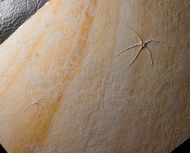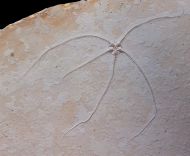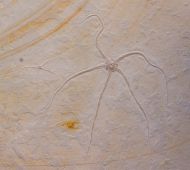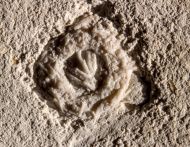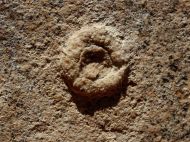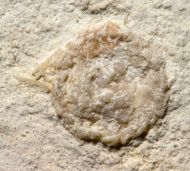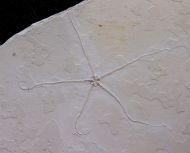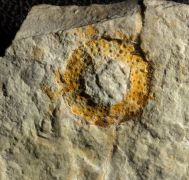Fossils for sale
Echinoderms

Echinoderms from the Solnhofen Limestone
Echinoderms are generally very rare in the Solnhofen limestones, with the exception of the free‑swimming crinoid Saccocoma tenella, which occurs in large numbers in the so‑called “Knöpfel beds”*. These horizons are a local peculiarity of the Solnhofen and Eichstätt plattenkalk deposits. When echinoderms are preserved, they often show exceptionally fine detail.
Overview of known Echinoderms
| Group | Typical species / examples | Remarks |
|---|---|---|
| Brittle stars (Ophiuroidea) | Geocoma carinata, Ophiura sp. | Very rare, except at the localities Hienheim and Zandt; there occasionally preserved with complete arms. |
| Sea urchins (Echinoidea) | Rhabdocidaris orbignyana | Spectacular rarity, especially known from Painten; usually single specimens. |
| Crinoids (Crinoidea) | Saccocoma tenella, Comaturella sp. | Saccocoma abundant particularly in the “Knöpfel beds”; Comaturella as another free‑swimming form. All others only as isolated finds. |
| Starfish (Asteroidea) | Riedaster reicheli | Very rare, apart from some remarkable finds from the classic locality Ried (now exhausted). |
| Sea cucumbers (Holothuroidea) | occasional | Hardly documented, preserved only in exceptional cases. |
Significance and Special Features
In the core plattenkalk deposits of Eichstätt and Solnhofen, echinoderms are overall very rare. Most forms were benthic and suffered from the hostile conditions on the lagoon floor (oxygen‑poor, hyposaline, fine lime mud). Exceptions are the free‑swimming forms such as Saccocoma and Comaturella, which were not dependent on the bottom and are therefore more frequently preserved. The “Knöpfel beds”* with mass occurrences of Saccocoma are a local peculiarity of the Solnhofen and Eichstätt plattenkalks.
*“Knöpfel beds” (local horizons named after the button‑like appearance of mass accumulations of Saccocoma)
References
- Jaekel, O. (1892): On Saccocoma and related crinoids. Zeitschrift der Deutschen Geologischen Gesellschaft 44: 1–48.
- Barthel, K.W., Swinburne, N.H.M. & Conway Morris, S. (1990): Solnhofen. A Study in Mesozoic Palaeontology. Cambridge University Press.
- Röper, M. & Reich, M. (2015): Overview of the distribution of Echinodermata in the Upper Jurassic plattenkalks of southern Germany. Zitteliana B 32: 101–118.
- LfU Bayern (2022): Fossil site Solnhofen limestones.
This fossil echinoid from Painten snows many spines.
These spine have a longitudinal striated ornamentation
Der fossile Seeigel selber misst etwa 10 mm im Druchmesser.
